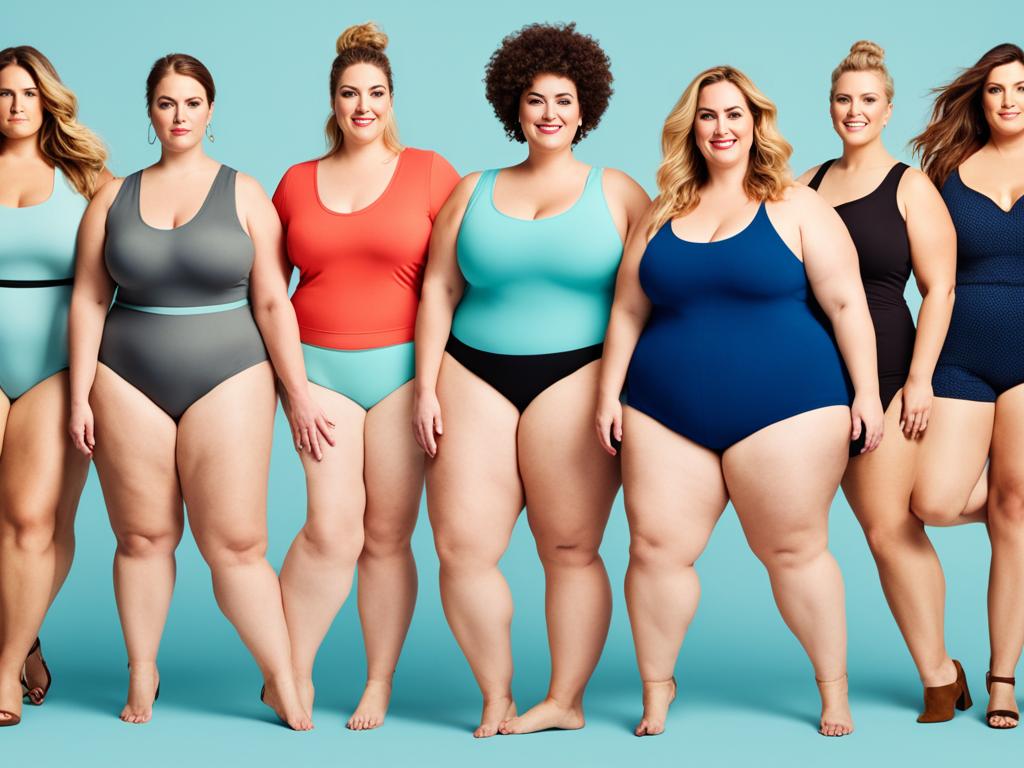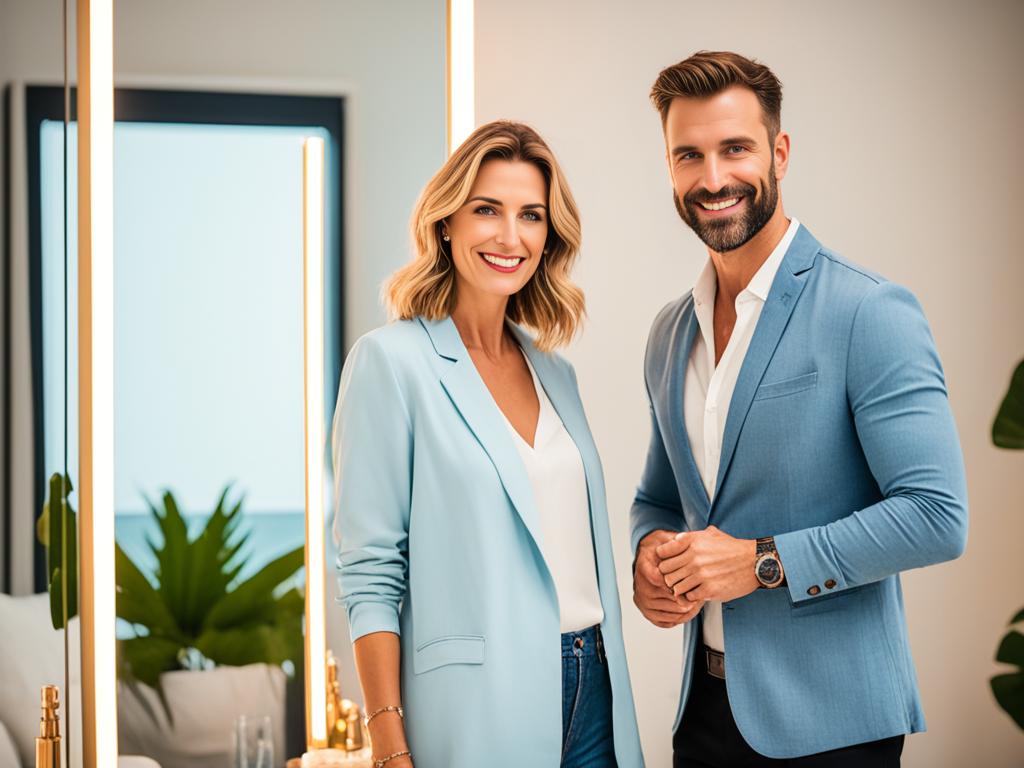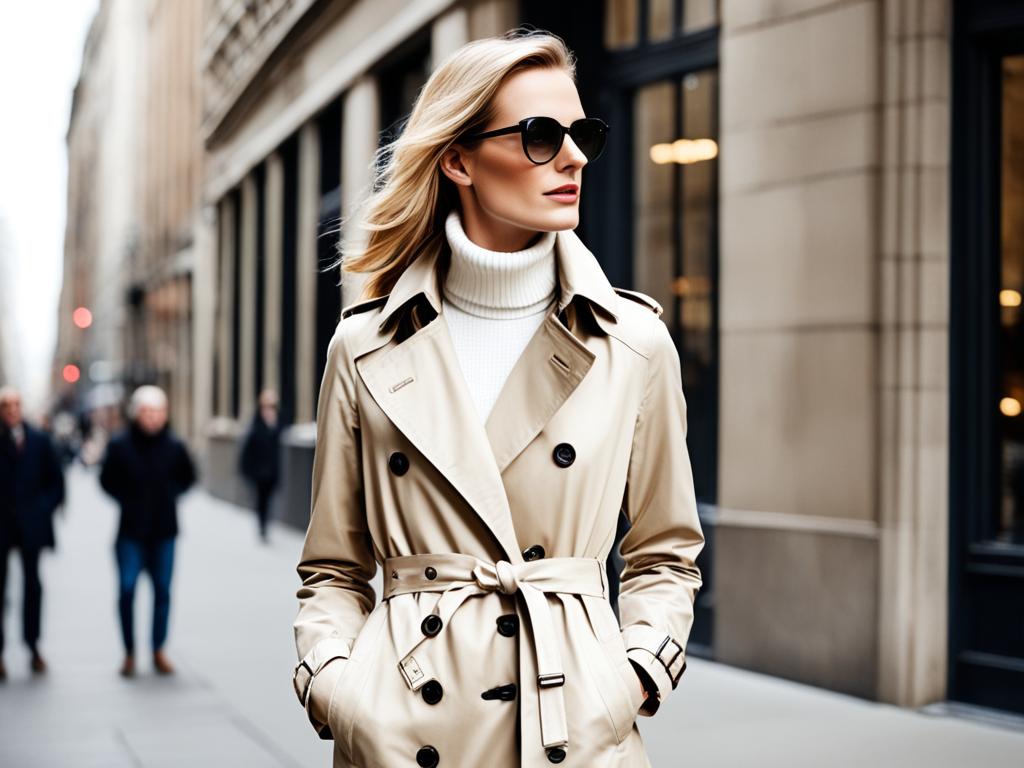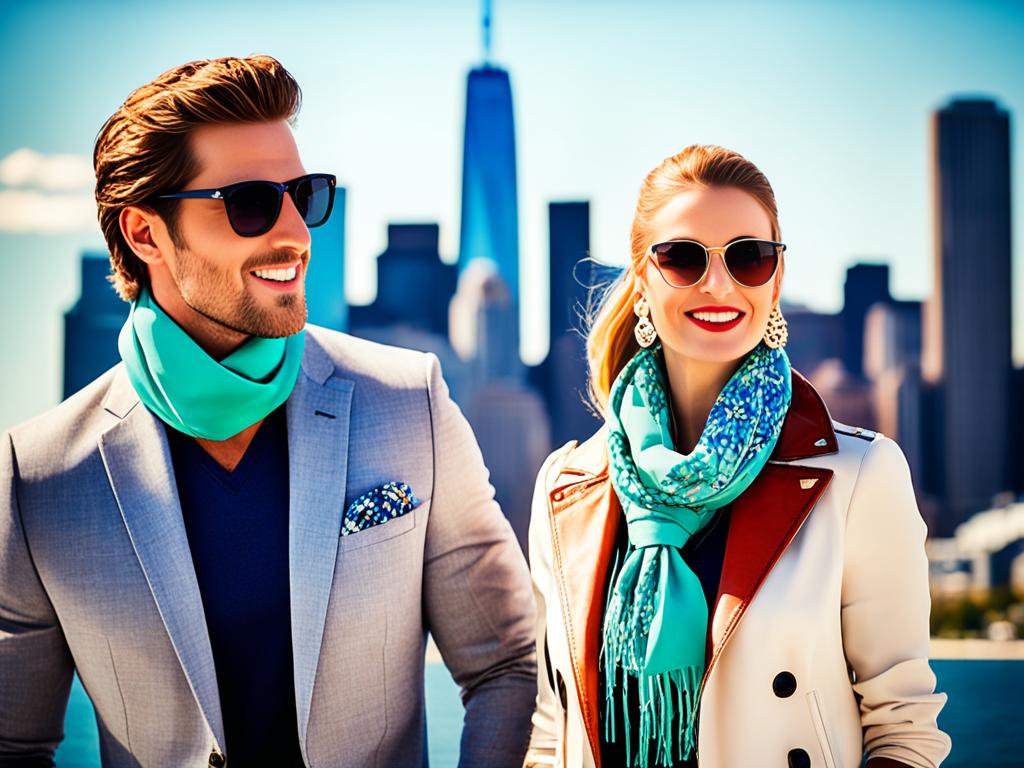Have you ever wondered what it takes to truly dress well? Is it about following the latest fashion trends, or is there more to it? In this comprehensive guide, we’ll uncover the secrets to dressing well for both women and men. From fashion tips and style advice to clothing guidelines and outfit suggestions, we’ll explore all aspects of dressing for success. Get ready to elevate your wardrobe and boost your confidence!
Key takeaways
- Understanding your body type is essential when choosing clothes that flatter your figure and enhance your best features.
- The choice of fabrics plays a crucial role in both comfort and style. Natural or synthetic, the right fabric can make all the difference.
- Dressing appropriately for different occasions is a surefire way to make a positive impression.
- Balancing trends with timeless pieces is the secret to creating a stylish wardrobe that stands the test of time.
- Accessories have the power to elevate any outfit and add a personal touch to your style.
Understanding Body Types and Best Fits
Understanding your body type is essential when it comes to choosing clothes that flatter your figure and enhance your best features. Whether you’re a man or a woman, dressing for your body type can make a significant difference in how you look and feel. In this section, we will explore various body types and provide you with expert advice on the best fit and styling techniques for each.
Trapezoid Body Type
The trapezoid body type is characterized by broad shoulders and a narrow waist and hips. To accentuate your body shape, opt for clothing that enhances your shoulders and balances your proportions. Choose tailored jackets, structured blazers, and tops that cinch at the waist. A-line skirts and pants with a slight flare can create the illusion of curves. Avoid oversized or boxy silhouettes that may make you appear broader.
Rectangular Body Type
Those with a rectangular body type have a straight and athletic figure. The goal is to create the illusion of curves and define the waistline. Opt for clothing that adds volume to the upper and lower body, such as peplum tops, ruffled blouses, or dresses with ruching. Belted garments can help create definition at the waist. Consider choosing high-waisted bottoms to elongate your legs and create a more proportional silhouette.
Oval or Triangle/Inverted Triangle Body Type
Oval or triangle/inverted triangle body types have a fuller bust, wider midsection, and narrower hips. The key is to balance the upper and lower body while creating definition and emphasizing the waist. Choose tops with V-necks or scoop necklines to draw attention upward. A-line skirts, fit-and-flare dresses, and wide-leg pants can add volume and create a more hourglass-like shape. Avoid oversized or baggy clothing that may swamp your figure.
Pear Body Type
Pear-shaped body types have narrower shoulders and wider hips. The aim is to accentuate the shoulders and balance the proportions with clothing that draws attention upward. Opt for tops with interesting necklines or details, such as boatnecks or statement sleeves. A-line or flared skirts can help create a more balanced silhouette. When choosing pants, opt for straight or wide-leg styles to create a more proportional look.
Straight (Rectangle) Body Type
Straight or rectangular body types have a similar width throughout the bust, waist, and hips. The goal is to create curves and definition. Choose clothing that adds volume and shape to the bust and hips, such as tops with ruffles, pleats, or embellishments. Wrap dresses and skirts can help create the illusion of curves. Opt for bottoms with a slight flare to add more shape to your silhouette.
Apple Body Type
Apple-shaped body types carry most of their weight in the midsection, with narrower hips and a generous bust. The focus is on creating a balanced silhouette by accentuating the legs and bust while minimizing the midsection. Choose tops with V-necks or open necklines to elongate the torso. A-line dresses, empire-waist tops, and high-waisted bottoms can help create a more defined waistline. Avoid clingy or tight-fitting clothing around the midsection.
Hourglass Body Type
Hourglass body types have a well-defined waistline, with the bust and hips of similar proportions. The aim is to highlight the waist and enhance the natural curves. Choose fitted tops and dresses that accentuate the waist. Wrap dresses, peplum tops, and pencil skirts can emphasize your curves. Opt for tailored bottoms that follow your natural shape, and avoid loose or boxy garments.

By understanding your body type and incorporating the right fit and styling techniques, you can enhance your appearance and feel more confident in your clothing. Experiment with different styles, try on different silhouettes, and remember to embrace your unique shape. Dressing for your body type is all about celebrating your individuality and feeling good in what you wear.
Choosing the Right Fabrics for Comfort and Style
The choice of fabrics is essential to achieving both comfort and style. By selecting the right fabrics, you can ensure that your clothes not only feel good against your skin but also complement your overall look. This section will provide you with a comprehensive guide to fabric properties, including information on natural and synthetic fabrics. It will also discuss the importance of seasonal fabric selection, ensuring you are prepared for different weather conditions.
A Guide to Fabric Properties
Understanding fabric properties is crucial to making informed decisions when it comes to choosing the right clothes. Different fabrics have distinct characteristics that affect their performance and durability. Some fabrics are known for their breathability, while others offer moisture-wicking properties or insulation. By considering these properties, you can select fabrics that match your needs and preferences. Whether you’re looking for lightweight and airy materials for summer or warm and cozy fabrics for winter, this guide will help you make the right choices.
Natural vs Synthetic Fabrics
Natural fabrics, such as cotton, silk, and wool, are derived from plant or animal sources. These fabrics are known for their breathability, softness, and ability to regulate body temperature. On the other hand, synthetic fabrics, such as polyester, nylon, and rayon, are man-made and offer durability, wrinkle resistance, and moisture-wicking properties. Understanding the characteristics of both natural and synthetic fabrics will allow you to make informed decisions based on your preferences and specific clothing requirements.
Seasonal Fabric Selection
Choosing the right fabrics for each season ensures that you stay comfortable and stylish throughout the year. Lightweight and breathable fabrics like linen and cotton are ideal for hot summer months, while heavier materials like wool and cashmere provide warmth during the colder seasons. By considering the weather conditions and selecting fabrics that suit the season, you can dress appropriately while still looking fashionable. This section will guide you in making the right fabric choices for each season, ensuring that your wardrobe is versatile and adaptable.
Dressing for Different Occasions
Knowing how to dress appropriately for different occasions is crucial to making a positive impression. Whether you’re attending a formal event, going on a casual outing, or navigating a business setting, dressing appropriately shows respect and professionalism. Moreover, special occasions demand a touch of elegance and style. To ensure that you always dress appropriately for each occasion, here are some helpful tips and outfit suggestions.
For formal events, such as weddings or black-tie galas, classic formal attire is essential. Men can opt for a tailored suit in a dark color, paired with a crisp dress shirt and a tie. Women, on the other hand, can consider wearing a sophisticated evening gown or a chic cocktail dress. Accessorizing with statement jewelry and a sleek hairstyle can further elevate the overall look.

Casual outings provide more flexibility in terms of attire. Men can go for a well-fitted pair of jeans or chinos, paired with a button-down shirt or a polo shirt. Women can opt for a comfortable dress or a skirt paired with a simple top. Adding accessories and comfortable shoes can enhance the casual yet stylish appearance.
In a business setting, it is essential to project professionalism and authority through your attire. Men should wear tailored suits, dress shirts, and ties, while women can opt for tailored pantsuits, skirts, or dresses paired with blouses. Neutral colors and conservative styles are recommended to maintain a polished and refined look.
Lastly, special occasions call for an outfit that combines elegance and personal style. Whether it’s a birthday celebration, an anniversary, or a holiday party, it’s an opportunity to showcase your fashion flair. Men can consider wearing a tailored blazer with dress pants and a stylish shirt. Women can opt for a trendy dress or a statement jumpsuit, paired with accessories that complement the outfit and reflect their personal style.
How to Dress Well: Balancing Trends with Timelessness
When it comes to fashion, striking the perfect balance between staying on-trend and maintaining a timeless wardrobe is essential. By incorporating trendy elements with classic pieces, you can create a stylish and versatile wardrobe that reflects your unique style. Let’s explore some valuable fashion advice on how to achieve this balance.
Identifying Timeless Wardrobe Essentials
Timeless wardrobe essentials are the foundation of any stylish ensemble. These pieces are characterized by their enduring style and versatility, making them suitable for various occasions and seasons. Think of a tailored blazer, a crisp white button-down shirt, a little black dress, and a well-fitted pair of jeans. These timeless pieces can be effortlessly mixed and matched with trendy elements to create fashionable outfits that stand the test of time.

Incorporating Trendy Elements with Classic Pieces
Incorporating trendy elements into your wardrobe adds a fresh and modern twist to your classic pieces. Stay updated with the latest fashion trends by keeping an eye on fashion magazines, following fashion influencers, and browsing online stores. From vibrant colors and bold patterns to statement accessories and trendy footwear, there are countless ways to infuse current fashion trends into your timeless wardrobe. Remember, it’s about selecting trendy elements that complement your personal style and enhance your classic pieces, rather than blindly following every passing trend.
The key to balancing trends with timelessness is to choose trendy elements that can easily be replaced or removed when the trend fades. This way, you can continue to wear your classic pieces while effortlessly incorporating new fashion trends into your wardrobe.
By combining timeless wardrobe essentials with trendy elements, you can curate a wardrobe that is both stylish and enduring. Follow these fashion tips to strike the perfect balance and create a wardrobe that reflects your individuality, embraces current fashion trends, and stands the test of time.
Accessorizing to Elevate Your Outfit
Accessories have the power to elevate any outfit and add a personal touch to your style. They are the finishing touches that can make a simple look extraordinary and showcase your unique personality. When it comes to accessorizing, the key is to strike the right balance and choose pieces that complement your outfit while reflecting your personal style.
The Impact of the Right Accessories
The right accessories can completely transform an outfit, taking it from ordinary to exceptional. They have the ability to enhance your overall look and make a statement. Whether it’s a statement necklace, a stylish belt, a colorful scarf, a trendy bag, or a pair of statement shoes, each accessory has its own way of adding that extra flair and elevating your outfit to new heights.
When selecting accessories, consider the occasion and the mood you want to convey. For a formal event, opt for elegant and refined accessories that exude sophistication. On the other hand, for a casual outing, you can experiment with bolder and more playful accessories that showcase your personal style.
Choosing Accessories that Reflect Your Personality
Your accessories should be an extension of your personal style and reflect who you are. They provide an opportunity to showcase your individuality and add a unique touch to your outfit. When choosing accessories, consider your personal preferences, interests, and the image you want to project.
If you have a bohemian style, consider incorporating accessories with natural materials like wooden bangles, feather earrings, or a fringed bag. For a minimalist look, opt for sleek and simple accessories in muted colors. And if you love vibrant colors and patterns, embrace statement accessories that make a bold impact.

When it comes to accessorizing, the possibilities are endless. Experiment with different combinations, mix and match, and have fun with it. Remember, accessories are a powerful tool for expressing your personal style and adding that extra touch of uniqueness to your outfits.
Wardrobe Maintenance and Garment Care
Proper wardrobe maintenance and garment care are essential for keeping your clothes in top condition and maximizing their longevity.
Essential Tips for Clothing Longevity
To extend the lifespan of your clothes, it’s important to take proper care of them. Start by properly storing your garments. Make sure to hang delicate items on padded hangers to avoid stretching, and use moth repellents to protect against pests. Folding knits and other lightweight fabrics can help prevent stretching and maintain their shape.
Cleaning is another crucial aspect of clothing longevity. Follow the care instructions on the garment’s label to determine the appropriate cleaning method. For delicate pieces, consider professional dry cleaning to avoid any damage. Regularly launder your clothes to remove dirt, sweat, and odors, but avoid excessive washing as it can cause unnecessary wear and tear.
Organizing your wardrobe can also contribute to clothing longevity. Keep your clothes neatly folded or hung to prevent wrinkles and creases. Use dividers and organizers to separate different categories and make it easier to find specific items without rummaging through the entire wardrobe. Additionally, periodically assess your wardrobe and remove any items that you no longer wear to make room for new additions.
Stain Removal and Fabric Preservation
Accidental spills and stains are a common occurrence, but they shouldn’t mean the end of your favorite garment. Knowing how to effectively remove stains can help save your clothes. Act quickly and blot the stain with a clean cloth or paper towel to absorb as much of the spill as possible. Use a stain remover or a mixture of mild detergent and water to treat the stain. Gently rub the affected area, but avoid scrubbing vigorously, as it can damage the fabric. Rinse thoroughly and wash as directed.
Preserving the quality of fabrics is equally important. Avoid exposing your clothes to direct sunlight for extended periods, as it can cause fading and discoloration. When ironing, use the appropriate temperature setting for each fabric type and consider placing a clean cloth between the iron and the garment to avoid direct contact. Additionally, avoid using harsh chemicals or excessive heat when drying your clothes, as it can weaken the fabric fibers.
By incorporating these stain removal and fabric preservation methods into your garment care routine, you can maintain the beauty and longevity of your clothing collection.
Developing Personal Style and Confidence
Developing a personal style is an essential part of expressing your individuality and boosting your confidence. It goes beyond simply following fashion trends and allows you to embrace your unique identity through fashion.
One of the first steps in developing your personal style is finding inspiration. Look for fashion icons, influencers, or even friends whose style resonates with you. Take note of the colors, patterns, and silhouettes that catch your eye. This will help you understand your preferences and guide you toward creating a wardrobe that truly reflects who you are.
Self-expression plays a vital role in personal style development. Clothing is a powerful medium for expressing your personality, passions, and interests. Don’t be afraid to experiment with different looks and take risks. Mix and match patterns, play with textures, and incorporate unexpected elements into your outfits. Remember, fashion is a form of self-expression, and the more you show your true self, the more confident you’ll feel.
“Fashion is about dressing according to what’s fashionable. Style is more about being yourself.” – Oscar de la Renta
Embracing your individuality is the cornerstone of developing a personal style. Don’t feel pressured to conform to societal norms or follow the latest trends if they don’t resonate with you. Instead, focus on pieces that make you feel comfortable and confident. Whether it’s a bold statement piece or a timeless classic, choose clothing that celebrates your uniqueness.
Building a wardrobe that reflects your personal style takes time and experimentation. Start by curating a collection of versatile pieces that can be mixed and matched effortlessly. Invest in quality basics that form the foundation of your wardrobe and complement them with statement pieces that showcase your personality. This combination of classics and unique pieces will allow you to create endless outfit possibilities.
Ultimately, personal style development is about discovering what makes you feel your best and embracing it. It’s about expressing your individuality, boosting your confidence, and celebrating your uniqueness through fashion. So go ahead, embrace your personal style journey, and let it be a reflection of your true self.
